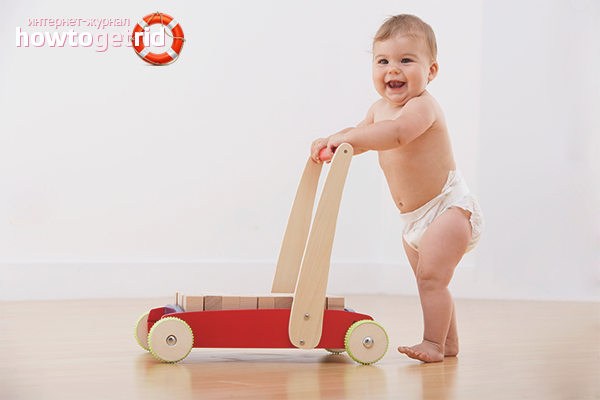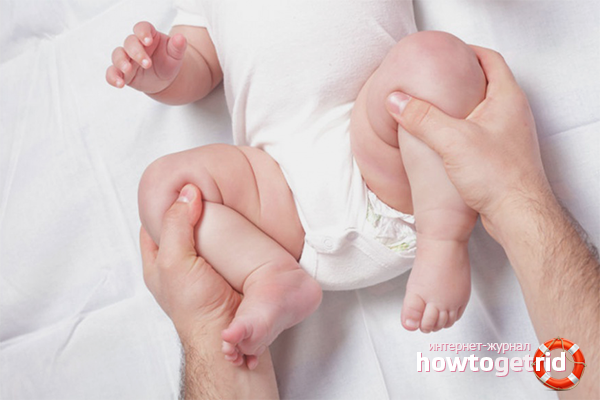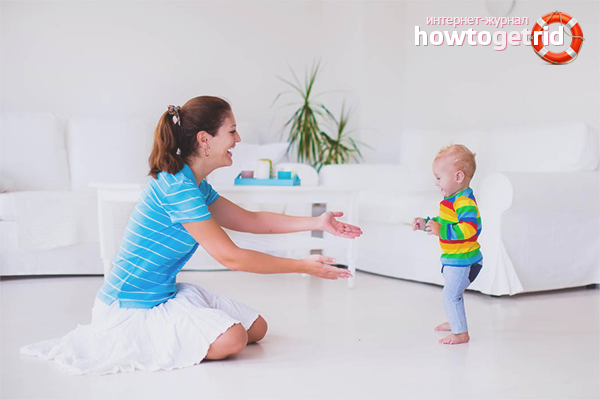The content of the article
The first years of a child’s life are the most interesting and touching. He begins to roll over, crawl, sit. By six months, little teeth begin to climb in the crumbs, he gradually eats adult food. But the most interesting and crucial moment is the beginning of independent walking. After your child gets up on his feet, he no longer needs to ask mom and dad to transfer him to the desired toy. Now he will choose the direction of movement himself.
But there are times when a child is growing, parents are impatiently waiting for the moment when he himself is flooding along the path, and this time still does not come. It's all about the unpreparedness of the baby. If his back, arms, legs and neck are not sufficiently strengthened, there can be no talk of any independent walking. So, when does the baby have to master this skill?
When a child begins to walk independently
To begin with, all children are different and they also develop in different ways. There is no single template - in how many months the baby should make certain successes. However, there are norms for healthy children, which determine the approximate terms of comprehension of various skills.
So, children on average after 9-10 months already confidently stand at the support. Closer to a year, most of the kids begin to walk. However, there are those who master this skill after a year and three to five months. The latest deadline for a child to learn to walk is a year and a half. It is believed that healthy children learn this skill earlier. If your baby does not go one and a half - this is a serious reason to urgently contact a pediatric neurologist.
How to prepare your child for walking
Teaching a child to walk better at home. Remove all carpets and rugs from the floor that the baby may trip over. If the child walks on the floor in socks - he may slip. Therefore, it is better to choose socks with rubberized soles. It is very good to learn to walk in nature or on the football field. It’s spacious there - the child can go wherever he wants. A pleasant lawn will soften the blow from falling. If you have the opportunity, learn to walk on the sandy shore - the sand also perfectly absorbs and prevents injuries.
When walking around the house, do not forget about the obstacles that can ruin the mood of your baby. Cover the corners of the furniture with special silicone pads that will soften the impact if necessary. Think about sockets located at the height of children's growth. From the moment you start independent walking, you need to close them with caps.
Gymnastics for the development of the muscles of the child
If the baby does not get on its feet and does not even try to do it, perhaps he is not strong enough for this. To make a baby physically stronger, he needs to be trained.
- Encourage crawling baby. When the baby crawls, it strengthens the cervical and lumbar spine. Therefore, do not rush the child, give him plenty of crawl. Entertain him with a bright toy from the other end of the room, crawl with him.
- Do gymnastics with your child.Put the baby on his back and bend his knees and ankles alternately. Rotate the legs at their very base.
- Walk more with the child at home and on the street, holding him by two handles. When the baby is comfortable enough, you can hold it only for one hand. So, gradually the baby learns to balance and coordinate movements.
- To show the baby the correctness of his future movements, put the child’s legs on his feet. Cross over in small steps, showing the baby how exactly you need to move your legs.
- It is very good to arrange the house supports. For example, a child can hold on to a sofa, but cannot go to the kitchen, since there is nothing to hold on to along the way. To solve this problem, you need to put chairs around the house. The kid will move independently. This will not only give the child confidence, but also train his skill.
These simple exercises, performed daily, will very soon yield results.
Massage for muscle training
Many mothers know how massage has a positive effect on the baby - after several sessions, the baby shows new skills. In order to push the crumb to independent walking, you need to do at least 10 massage sessions. Of course, a massage made by a specialist is more professional and will bring more benefits. However, if you do not have the opportunity to pay for the services of a massage therapist, you can do the massage yourself. It will also bring many benefits.
- Warm the room so that the child is not cold. Undress the baby and lay it on a hard, flat surface. Prepare a clean diaper and hypoallergenic massage oil. If you are doing massage for the first time - talk with the child, calm him with his voice, say affectionate words. The kid must understand that nothing bad is waiting for him, mom is nearby.
- Start the massage with the legs, or rather, the feet. Just rub your fingers and feet, remember them with your hands. Squeeze your hand into a fist and walk them on the foot. Next, work out the back of the foot with your thumb.
- After that, carefully remember the legs - you need to rub from the feet to the hips. If a child is diagnosed with hypertonicity, the movements should be relaxing, calming, and stroking. If the baby is diagnosed with hypotension, the movements should be strong (but not painful). With this diagnosis, you need to make light slaps with the back of your hand. So that the baby's muscles come in tone.
- After that, stretch your palms and hands. The technique is the same as with the legs. After a massage on your hands, you can do several exercises of physiotherapy exercises. For example, invite the child to hold the stick with his hands, and slowly raise the stick yourself. So develops the strength of the arms, shoulders and neck.
- After that, work out the front of the body. Breast should be slightly pinched, massaged with fingers, rubbed with rotational movements. Massage your stomach in a clockwise direction to improve digestion.
- After this, you need to put it on your stomach and begin to massage the back. With two thumbs of both hands, press the muscles along the spine. Do this carefully, but surely.
- Do not forget to massage your neck, especially if you notice that the baby turns his head only in one direction. This part of the massage is quite painful, but very effective.
A good quality massage lasts at least 15 minutes. He will certainly improve the health status of your child and give him strength. After the massage, many children sleep long and sound sleep. This is another indicator of good performance.
How to teach a child to walk
After all these preparations, it is important to begin walking. How to teach a child to walk? How to push him to these actions? There are some tips to help you speed up the long-awaited moment.
- The most optimal way is to put the child between mom and dad and alternately call the baby one parent.For example, the child is near the dad, and the mother friendly calls his "bunny". The kid will certainly want to get into his mother’s arms and will try to walk towards her. It is important to ensure a small distance - making a couple of steps is much easier than 10. Gradually, the distance can be increased. When the child reaches mom, dad calls him back.
- In the process of learning to walk, it is very important to relate to the fall. If parents rush to the crumbs after any bruise, the baby will perceive it as something terrible. The child must understand that falling is an integral part of life. Fell - do not panic. Help the child rise, brush off his knees and go back into battle. But beware of the baby from serious injuries. A strong fall can cause a child to fear pain and the baby will abandon his attempts to walk for a long time.
- Learn to walk where the baby likes. Perhaps your child likes to walk in the autumn park and collect yellow leaves. Wear a waterproof jumpsuit - and go. There he will learn to walk much faster, for motivation. At home, you can beckon with your favorite toys.
- In the first stages, you can put on a child special leashes that protect the baby from falling. But the use of walkers is not recommended - modern pediatricians believe that they are harmful enough for the spine.
- Encourage your child to walk in every way. Going for a walk, discard the stroller. Pay attention to crumbs on older children - how they run and walk. Do not rush to constantly pick up the baby.
- To make the child interested in moving around, you can give him a typewriter on a string. Rolling it, he himself will not notice that he walks on his own.
- Build mountains of pillows and blankets at home. Overcoming such obstacles develops the strength, dexterity and musculature of the crumbs.
These simple tips and rules will help you teach your child how to walk as quickly as possible.
Know that all the children are different and you do not need to compare your baby with neighboring children. Someone begins to walk early, someone late - there is nothing shameful in this. Take care of the child and love him for who he is.
Video: baby learns to walk












Submit